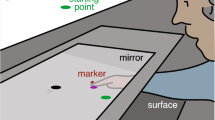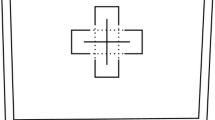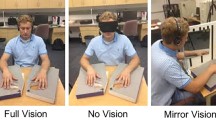Abstract
A characteristic of visuomotor tracking of non-regular oscillating stimuli are high-frequency jittery corrective motions, oscillating around the tracked stimuli. However, the properties of these corrective jitter responses are not well understood. For example, does the jitter response show an idiosyncratic signature? What is the relationship between stimuli properties and jitter properties? Is the jitter response similar across effectors with different inertial properties? To answer these questions, we measured participants’ jitter frequencies in two tracking tasks in the arm and the finger. Thirty participants tracked the same set of eleven non-regular oscillating stimuli, vertically moving on a screen, once with forward–backward arm movements (holding a tablet stylus) and once with upward–downward index finger movements (with a motion tracker attached). Participants’ jitter frequencies and tracking errors varied systematically as a function of stimuli frequency and amplitude. Additionally, there were clear individual differences in average jitter frequencies between participants, ranging from 0.7 to 1.15 Hz, similar to values reported previously. A comparison of individual jitter frequencies in the two tasks showed a strong correlation between participants’ jitter frequencies in the finger and the arm, despite the very different inertial properties of the two effectors. This result suggests that the corrective jitter response stems from common neural processes.





Similar content being viewed by others
References
Arueti M, Perach-barzilay N, Tsoory MM, Berger B, Getter N, Shamay-Tsoory SG (2013) When two become one: the role of oxytocin in interpersonal coordination and cooperation. J Cognitive Neurosci 25(9):1418–1427. doi:10.1162/jocn_a_00400
Brainard DH (1997) The psychophysics toolbox. Spat Vis 10(4):433–436. doi:10.1163/156856897X00357
Burdet E, Milner TE (1998) Quantization of human motions and learning of accurate movements. Biol Cybern 78(4):307–318. doi:10.1007/s004220050435
Dickey AS, Amit Y, Hatsopoulos NG (2013) Heterogeneous neural coding of corrective movements in motor cortex. Front Neural Circuits 7:51. doi:10.3389/fncir.2013.00051
Dipietro L, Poizner H, Krebs HI (2014) Spatiotemporal dynamics of online motor correction processing revealed by high-density electroencephalography. J Cogn Neurosci 26(9):1966–1980. doi:10.1162/jocn_a_00593
Doeringer JA, Hogan N (1998) Serial processing in human movement production. Neural Netw 11(7–8):1345–1356. doi:10.1016/S0893-6080(98)00083-5
Dumas G, Nadel J, Soussignan R, Martinerie J, Garnero L (2010) Inter-brain synchronization during social interaction. PLoS One 5(8):e12166. doi:10.1371/journal.pone.0012166
Flash T, Henis EA (1991) Arm trajectory modification during reaching towards visual targets. J Cogn Neurosci 3(3):220–230. doi:10.1162/jocn.1991.3.3.220
Fleishman E (1967) Individual differences and motor learning. In: Gange R (ed) Learning and individual differences. Merrill, Columbus, pp 165–191
Franz EA, Zelaznik HN, Smith A (1992) Evidence of common timing processes in the control of manual, orofacial, and speech movements. J Mot Behav 24(3):281–287. doi:10.1080/00222895.1992.9941623
Friedman J (2014) Repeated measures (computer software). doi:10.5281/zenodo.10438
Friedman J, Flash T (2009) Trajectory of the index finger during grasping. Exp Brain Res 196(4):497–509. doi:10.1007/s00221-009-1878-2
Friedman J, Brown S, Finkbeiner M (2013) Linking cognitive and reaching trajectories via intermittent movement control. J Math Psychol 57(3–4):140–151. doi:10.1016/j.jmp.2013.06.005
Friedman J, Alon U, Noy L (2014) Stimuli to accompany the article “Corrective jitter motion shows similar individual frequencies for the arm and the finger.” Retrieved Sept 17, 2014, from http://dx.doi.org/10.6084/m9.figshare.1172073
Gawthrop P, Loram I, Lakie M, Gollee H (2011) Intermittent control: a computational theory of human control. Biol Cybern 104(1–2):31–51. doi:10.1007/s00422-010-0416-4
Hart Y, Noy L, Feniger-Schaal R, Mayo AE, Alon U (2014) Individuality and togetherness in joint improvised motion. PLoS One 9(2):e87213. doi:10.1371/journal.pone.0087213
Ivry RB, Spencer RM, Zelaznik HN, Diedrichsen J (2002) The cerebellum and event timing. Ann NY Acad Sci 978(1):302–317. doi:10.1111/j.1749-6632.2002.tb07576.x
Karniel A (2013) The minimum transition hypothesis for intermittent hierarchical motor control. Front Comput Neurosci 7:12. doi:10.3389/fncom.2013.00012
Keele SW, Hawkins HL (1982) Explorations of individual differences relevant to high level skill. J Mot Behav 14(1):3–23. doi:10.1080/00222895.1982.10735259
Keele SW, Ivry RI (1987) Modular analysis of timing in motor skill. The psychology of learning and motivation: advances in research and theory, vol 21. Academic Press, San Diego, pp 183–228
Keele SW, Ivry RI, Pokorny RA (1987) Force control and its relation to timing. J Mot Behav 19(1):96–114. doi:10.1080/00222895.1987.10735402
Khoramshahi M, Shukla A, Billard A (2014) Cognitive mechanism in synchronized motion: an internal predictive model for manual tracking control. In: The 2014 IEEE international conference on systems, man, and cybernetics (SMC2014), San Diego. doi:10.1109/SMC.2014.6974003
King AC, Ranganathan R, Newell KM (2012) Individual differences in the exploration of a redundant space-time motor task. Neurosci Lett 529(2):144–149. doi:10.1016/j.neulet.2012.08.014
Konvalinka I, Vuust P, Roepstorff A, Frith CD (2010) Follow you, follow me: continuous mutual prediction and adaptation in joint tapping. Q J Exp Psychol 63(11):2220–2230. doi:10.1080/17470218.2010.497843
Krebs HI, Aisen ML, Volpe BT, Hogan N (1999) Quantization of continuous arm movements in humans with brain injury. Proc Natl Acad Sci USA 96(8):4645–4649. doi:10.1073/pnas.96.8.4645
Masumoto J, Inui N (2013) Two heads are better than one: both complementary and synchronous strategies facilitate joint action. J Neurophysiol 109(5):1307–1314. doi:10.1152/jn.00776.2012
Masumoto J, Inui N (2014) A leader-follower relationship in joint action on a discrete force production task. Exp Brain Res 232(11):3525–3533. doi:10.1007/s00221-014-4041-7
Miall RC, Jackson JK (2006) Adaptation to visual feedback delays in manual tracking: evidence against the smith predictor model of human visually guided action. Exp Brain Res 172(1):77–84. doi:10.1007/s00221-005-0306-5
Miall RC, Weir DJ, Stein JF (1986) Manual tracking of visual targets by trained monkeys. Behav Brain Res 20(2):185–201. doi:10.1016/0166-4328(86)90003-3
Miall RC, Weir DJ, Stein JF (1993) Intermittency in human manual tracking tasks. J Mot Behav 25(1):53–63. doi:10.1080/00222895.1993.9941639
Morasso P, Casadio M, Mohan V, Zenzeri J (2010) A neural mechanism of synergy formation for whole body reaching. Biol Cybern 102(1):45–55. doi:10.1007/s00422-009-0349-y
Morrison S, Newell KM (2000) Postural and resting tremor in the upper limb. Clin Neurophysiol 111(4):651–663. doi:10.1016/S1388-2457(99)00302-8
Navas F, Stark L (1968) Sampling or intermittency in hand control system dynamics. Biophys J 8(2):252–302. doi:10.1016/S0006-3495(68)86488-4
Noy L, Rumiati RI, Flash T (2009) Simple movement imitation: are kinematic features sufficient to map perceptions into actions? Brain Cogn 69(2):360–368. doi:10.1016/j.bandc.2008.08.030
Noy L, Dekel E, Alon U (2011) The mirror game as a paradigm for studying the dynamics of two people improvising motion together. Proc Natl Acad Sci 108(52):20947–20952. doi:10.1073/pnas.1108155108
Rohrer B, Hogan N (2006) Avoiding spurious submovement decompositions II: a scattershot algorithm. Biol Cybern 94(5):409–414. doi:10.1007/s00422-006-0055-y
Schmiedek F, Oberauer K, Wilhelm O, Süß H-M, Wittmann WW (2007) Individual differences in components of reaction time distributions and their relations to working memory and intelligence. J Exp Psychol Gen 136(3):414–429. doi:10.1037/0096-3445.136.3.414
Slifkin AB, Vaillancourt DE, Newell KM (2000) Intermittency in the control of continuous force production. J Neurophysiol 84(4):1708–1718
Smith MC (1967) Theories of the psychological refractory period. Psychol Bull 67(3):202–213. doi:10.1037/h0020419
Sosnik R, Hauptmann B, Karni A, Flash T (2004) When practice leads to co-articulation: the evolution of geometrically defined movement primitives. Exp Brain Res 156(4):422–438. doi:10.1007/s00221-003-1799-4
Sosnoff JJ, Newell KM (2005) Intermittent visual information and the multiple time scales of visual motor control of continuous isometric force production. Percept Psychophys 67(2):335–344. doi:10.3758/BF03206496
Spencer RMC, Zelaznik HN, Diedrichsen J, Ivry RB (2003) Disrupted timing of discontinuous but not continuous movements by cerebellar lesions. Science 300(5624):1437–1439. doi:10.1126/science.1083661
Tang R, Müller H-G (2008) Pairwise curve synchronization for functional data. Biometrika 95(4):875–889. doi:10.1093/biomet/asn047
Vaillancourt D, Haibach P, Newell KM (2006) Visual angle is the critical variable mediating gain-related effects in manual control. Exp Brain Res 173(4):742–750. doi:10.1007/s00221-006-0454-2
Van Beers RJ, Haggard P, Wolpert DM (2004) The role of execution noise in movement variability. J Neurophysiol 91:1050–1063. doi:10.1152/jn.00652.2003
Van der Wel RPRD, Sternad D, Rosenbaum DA (2009) Moving the arm at different rates: slow movements are avoided. J Mot Behav 42(1):29–36. doi:10.1080/00222890903267116
Von Hofsten C (1991) Structuring of early reaching movements: a longitudinal study. J Mot Behav 23(4):280–293. doi:10.1080/00222895.1991.9942039
Watanabe T, Miwa Y (2012) Duality of embodiment and support for co-creation in hand contact improvisation. J Adv Mech Des Syst Manuf 6(7):1307–1318. doi:10.1299/jamdsm.6.1307
Yun K, Watanabe K, Shimojo S (2012) Interpersonal body and neural synchronization as a marker of implicit social interaction. Sci Rep 2:959. doi:10.1038/srep00959
Zelaznik HN, Spencer RM, Doffin JG (2000) Temporal precision in tapping and circle drawing movements at preferred rates is not correlated: further evidence against timing as a general-purpose ability. J Mot Behav 32(2):193–199. doi:10.1080/00222890009601370
Zelaznik HN, Spencer RMC, Ivry RB, Baria A, Bloom M, Dolansky L, Whetter E (2005) Timing variability in circle drawing and tapping: probing the relationship between event and emergent timing. J Mot Behav 37(5):395–403. doi:10.3200/JMBR.37.5.395-403
Zhai C, Alderisio F, Tsaneva-Atanasova K, Bernardo M (2014) Adaptive tracking control of a virtual player in the mirror game. In: 53rd IEEE conference on decision and control, Los Angeles
Acknowledgments
We thank Tomer Ilan for assistance in data collection. We thank the Braginsky Center for the Interface between Science and the Humanities, at the Weizmann Institute of Science for support (L.N. and U.A).
Conflict of interest
The authors declare that they have no conflict of interest.
Author information
Authors and Affiliations
Corresponding author
Rights and permissions
About this article
Cite this article
Noy, L., Alon, U. & Friedman, J. Corrective jitter motion shows similar individual frequencies for the arm and the finger. Exp Brain Res 233, 1307–1320 (2015). https://doi.org/10.1007/s00221-015-4204-1
Received:
Accepted:
Published:
Issue Date:
DOI: https://doi.org/10.1007/s00221-015-4204-1




